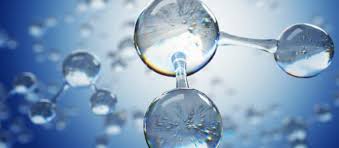

· By Andy Moretz
Ozone: Oxygen's Short-lived Kin
Those in the ‘Fine Print’ crowd may have noticed the innocuous–but still potentially eyebrow-raising–phrase at the bottom of their RAIN bottle: Processed by Ozonation. You don’t have to be a tenured etymologist to infer that ozonation isn’t a person or a place but a process, and that it is probably related to ozone gas. Specifically (per Merriam-Webster) it is ‘the treatment or combination of a substance or compound with ozone.’ In this case, water.
But, ozone? O₃? The same atmospheric hero filtering out baddie UV-B solar rays, but also conversely a delicate victim of CFCs and other now-banned refrigerants / styrofoam foaming agents? Yes, thrice over. It’s the same gas. (Note: the notorious hole in the ozone layer over the Antarctic that has terrorized several generations of schoolchildren now has thankfully shrunk considerably due to international agreements).
But, why ozone? What exactly does an extra oxygen atom bring to the table, and why add it to water? Before continuing, keep in mind that ozone is a very unstable molecule with a half-life of just 25 hours–meaning it will be long broken down into regular oxygen in any RAIN bottle you open. Ozone has to be made on-site and is only noticeable by taste in water directly consumed from the bottling line.
Because of this natural molecular decay, ozone is a safe disinfecting alternative to chlorine or a host of other chemical additives that do not transform to a harmless substance. Here at RAIN we make the nimble gas by using a mini-fridge size ozone generator rated at 45,000 volts. It generates a static discharge (basically as lightning creates it in the atmosphere) that converts oxygen into ozone, which is then piped and mixed with our spring water just before bottling and capping.
Ozone’s reactionary nature makes it a perfect treatment for water because as it decays into O₂ it releases a ‘free radical’ oxygen atom that directly attacks the surface of microorganisms and destroys their cell walls. This is actually a more effective antibacterial than chlorine et al and ozone also breaks down inorganic contaminants such as arsenic, iron and manganese, while also removing organic odors and micropollutants.
We’re quite confident in the taste and hydration of RAIN water, but the reality is that it does come from a big underground aquifer surrounded by abundant life in a temperate rainforest. We chose ozonation not because it sounds trendy or eco-hip, but because it is an entirely safe and effective method to eliminate organic and inorganic contaminant ‘hikejackers’ that may survive the earlier paper and UV filtration in the bottling process. Simply put, ozone does its disinfecting work thoroughly and then disappears without affecting RAIN’s sought-after fresh taste and low mineral content.
